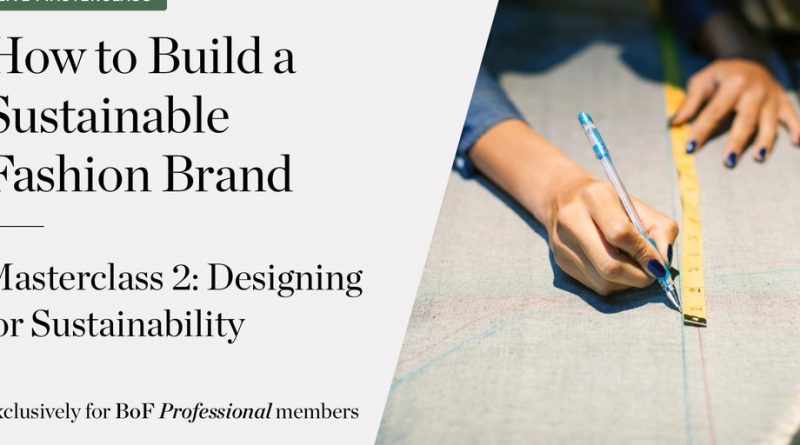How to Build a Sustainable Fashion Brand — Designing for Sustainability | News & Analysis, BoF Professional
LONDON, United Kingdom — Can design and profit align with doing social and environmental good?
In the second masterclass in #BoFLIVE’s new series, How to Build a Sustainable Fashion Brand, London Editor Sarah Kent was joined by Raeburn and Timberland Creative Director Christopher Raeburn, Cape Town-based sustainable textile designer Sindiso Khumalo and Mother of Pearl Creative Director Amy Powney for a virtual panel discussing how to design with environmental and social values in mind.
“The way we look at… every decision we make [is], is it the best possible decision we could make, what is the impact of that and could we be doing it better?” Powney said. “Whether that’s what fabric we’re using or what fibre we’re using or the garment itself. Does it really have a purpose?”
For the panelists, challenging the current mindset when it comes to designing requires more education. Existing tools to understand and manage fashion’s social and environmental impact should be at the forefront of fashion school curricula. Designers also need to do their own due diligence to understand their supply chains in order to effect change. Here the panel offers insights to help develop a creative process that is responsible to people and the planet.
Key Lessons from Masterclass 2: Designing for Sustainability
- The Three R’s: For Raeburn, making responsible decisions boils down to three simple principles: remake, reduce or recycle. The first collection he showcased at London Fashion Week was made from a single parachute and that mindset is something he incorporates into his business today. “We don’t talk about sustainability, we talk about our responsibility and we also talk about our obligation to make better choices… [because] 80 percent of the impact of that product you’re going to make is in the materials,” he said.
- Material Choices: “When you put pen to paper and you pick your fabric just look at the fabric and think ‘what even is this and where does it come from?’ Powney said. If you don’t know, do some research. That’s exactly what Powney did when she first started out. “Before we could design sustainable clothing we had to work out what does organic cotton even mean and where does that even come from and what’s the difference between organic cotton and conventional cotton?” she said.
- Grow Consciously: Venturing into sustainability can feel overwhelming and confusing, but Khumalo encourages designers to start small, to select an area of their business that they want to work on and go from there. “You can’t fix everything with your brand, however if you can bring some of those things into your business and value chain, I think that’s the best way,” she said.
- Respect the Craft: For Khumalo, her design process includes woven textiles produced by artisans in South Africa and Burkina Faso using local heritage techniques. “My premise is often… how can I bring this particular craft into a collection… for me it always starts with the craft,” she said. That might also mean taking a different approach to growth. Khumalo has established an order cut off point “because… I don’t want it to be some kind of factory that’s just like churning out hand woven cloth. I want the essence of it to live in the clothes… The slowness can be a limitation but I almost, I guess I embrace it.”
- Education: What we know about sustainability has evolved over the years and fashion schools need to ensure their teaching is up to date with these developments, Powney said. Getting first hand experience of how the manufacturing process works is essential for students because it illustrates the changes they can make as they grow their brands, Khumalo said. “I only got exposed to it after I started my business and I think that’s definitely an important part of the business… and I think lifting that lid very early on is crucial for students.”
Also, stay tuned for the next monthly episode of BoF’s online learning series How to Build a Sustainable Fashion Brand.
Masterclass 3: Tracking and Traceability
Speakers: Dio Kurazawa: Sustainability Consultant, The Bear Scouts; Hana Kajimura, Sustainability, Allbirds; Helen Crowley, Head of Sustainable Sourcing, Kering.
Key questions answered
- What should brands be tracking and measuring to enable meaningful change?
- Why is traceability so challenging?
Learning Outcomes
- Identify ways to track and measure impact
- Explain key metrics to monitor
Register for the next masterclass in How to Build a Sustainable Fashion Brand: Tracking and Traceability
Masterclass 4: Buying Better
Key questions answered
- How do you buy responsibly?
- What best practices enable the entire supply chain to act responsibly?
Learning Outcomes
- Identify collaborative models to drive change
- Propose improvements to partner relationships
Masterclass 5: The Case for Culture
Key questions answered
- How do companies create a culture that drives responsible business practices?
- What should companies be focusing on and why?
Learning Outcomes
- Identify factors that enable more inclusive and responsible operations
- Establish measurable objectives
Visit our calendar to find details of upcoming digital events and RSVP.


